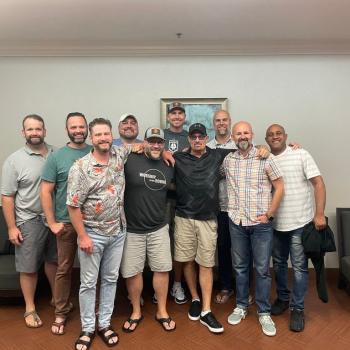Five Stones: Conquering Your Giants is a new book by Shane Stanford and R. Brad Martin.
The greatest battle the Christian faces is very often the battle with himself or herself.
Shane Stanford and R. Brad Martin use the story of David and Goliath to model how to fight and overcome our giants today.
The book seeks to inspire, challenge, and enhance self-discovery.
The author creatively apply the story of David and Goliath to every believer today.
Each stone represents a strategy for overcoming. The book is written with a lot of stories. It also includes a training manual at the end with practical suggestions and questions. This is always helpful.
What follows is an excerpt from the book to give you the flavor of it.
The First Stone: Draw A Clear Picture
“A man can’t be too careful in his choice of enemies.” – Oscar Wilde
Scripture reference
to David and Goliath
“Your servant has fought both lions and bears. This uncircumcised Philistine will be just like one of them because he has insulted the army of the living God.”
1 Samuel 17:36
John Beckee was an artist whose career flourished during the 1850’s. His name was not known past the local dealers and artists from the community where he lived, but his reputation was slowly making its way through the mainstream. His goal was to be the very best artist of his generation. However, John’s paintings were never the ‘art of the day’. His themes never touched the chord of the artistic world. Yet, one of John’s gifts was the ability to draw clear pictures of human beings and of actual settings—‘sketch out’ as it is called. They were precise and detailed, clearly depicting both the main subject and the context of a scene. The drawings were so good, many compared them to the new ‘photo picture machine’ that had recently made such a huge impact.
John’s work was useful. Law enforcement agencies, in particular, valued his skill. John created renderings of criminals on the loose, so that they could be found and brought to justice. He drew pictures of people who were in trouble, so that they could be found and given assistance.
It is estimated that John Beckee created renderings of thousands of people over the course of his career. His work was used to locate missing children, apprehend numerous criminals, and identify persons for various other important situations. His work made a real difference in people’s lives. There is certainly an important place for art in our world. But, at times, a simple, clear picture can be invaluable.
We must envision our desired outcome. We must focus on a clear image of what we are aiming for and where we are going. Surely young David focused on his desired outcome. There were many other possible outcomes in that moment: The giant could have exploded into a new rage and crushed the shepherd boy. Or he might have been injured by David’s first stone, and run back to his camp. Or he might have changed his mind about the whole thing, and simply walked away, leaving David and the Israelites alone. But David did not focus on any of those outcomes. Instead, he envisioned the giant dead, powerless, lying bloody and lifeless on the ground. We must focus on a clear picture of what we are aiming for and where we are going, but we must also picture how we will get there.
Seeing the Shot
Over the last generation of professional golfers, most agree that Jack Nicklaus was the greatest champion. For the past forty years, two generations of golfers sought to recreate Nicklaus’ example of success both on and off the course.
Nicklaus is a fascinating person. Incredibly well organized, he approaches every facet of his life from a very disciplined perspective. This included everything from his golf swing to his design of a new golf course.
In Nicklaus’ classic golf instruction book, ‘Golf My Way’, Nicklaus shares a significant principle for his success. He calls it ‘Seeing the Shot’. Nicklaus was a firm believer that every shot in golf, whether a longer shot or a shorter one required one swing. But, one of the most important parts of the shot happened before he ever hit the ball.
Nicklaus would stand behind the ball to begin his ‘pre-shot routine’. He would find a point just ahead of the ball that was on the line of his target and then he would ‘imagine the shot’. That’s right, before he ever hit a single golf shot, he would envision the shot in his mind, painting a clear picture of how he believed the shot should fly.
Nicklaus believed that by ‘seeing the shot’, the mind sent signals to the body during the golf swing (which is basically a series of muscle memory executions) and, thus, assisted the body during the actual shot as though the body ‘had experienced the shot before’. This technique became popular with the next generation of golfers, and the ‘pre-shot routine’ became as important as the swing itself. It gave the golfer a ‘mental picture’ of what they wanted to happen.
But, Nicklaus was not the only great athlete to use this technique. Hall of Fame running back, Jim Brown, used to sit at his locker before games and ‘see’ everything that he believed could happen during the game. He would then, purposefully (in his mind) remove the negative images and focus only on the positive ones. Brown considered this technique as critical to his success as the actual execution.
Sports psychologist calls this technique ‘visualization’. Visualization creates positive images in your mind before practice and competition. Its purpose is to simulate the event as clearly and vividly as possible to create a déjà vu experience when you are performing in real time. In the real time situation, your memory muscle is engaged, and your body responds accordingly, almost instinctively. The result increases a reaction time whereby you have programmed the mind and body to perform automatically and without hesitation. Speeding up this reaction time, if only minutely, can be the difference between executing at a high level and coming up just short.
In the story of David and Goliath, one of the first principles we see David use is to distinguish between Goliath the mythical figure and Goliath the champion warrior but a man who could still be killed. The rumors amid the Israelite encampment had Goliath at such an outrageous place in the Israelites’ psyche, that most of the soldiers were defeated long before they entered battle…
Sound familiar? Do you often feel defeated before you even begin the battle? How might your life be different if you developed a strong spiritual memory muscle? What if your thoughts and actions were consistently moving toward a positive outcome? What would it be like to feel empowered, capable, and confident? We must remove the obstacles of fear and distorted imagery. They cloud our thinking, dampen our resolve, and drag us into a state of inertia or even hopelessness. We must replace these obstacles with clear and positive images of our desired outcome and our path toward it.
Clarity
So, you must draw a clear picture of your desired outcome, and you must visualize how you will get there, developing a spiritual memory muscle so that you think and act instinctively, with positive motion toward your goal. But how, exactly? We’d like to offer three questions to help you clarify your own thoughts and conclusions.
1) Is it fact or fiction?
2) What is in the frame of the whole picture?
3) Is it winnable?
Question One: What is Fact and What is Fiction?
There is a great story that dates from the Civil War about an encounter between a young Union Soldier and Abraham Lincoln. Lincoln, who loved to walk over from the White House to the nearby Willard Hotel in order to calm his mind, arrived at the hotel one afternoon and sat in the front parlor. Across from Lincoln’s sofa was a young, Union soldier who was newly appointed to the staff of one of the Army’s generals. He was waiting on his commander to come down from his room.
Lincoln struck up a conversation with the young soldier about the progress of the war. The young soldier was new to conflict and still ‘wide-eyed’ about the uniforms, the fanfare, and the glory of it all. When Lincoln asked what he thought was the most important reason for recent successes of which the young soldier referenced, the young man replied, “It is the leadership of President Lincoln, sir.” Before Lincoln could offer a word of deference for the compliment, he realized that the young man had no idea who was sitting across the parlor from him.
‘Tell me about the President’ Mr. Lincoln smirkishly asked.
“Oh, he is a giant of a man” the young solider answered. “It is rumored that he walks as though almost on the clouds. His eyes are like fire, and his voice like the booming of trumpets.” The young soldier went on and on about his version of Lincoln—grand, glorious and completely… inaccurate.
Mr. Lincoln, the story goes, smiled, stood and shook the hand of the young soldier, and playfully said, “Well, then, with that countenance, I wonder why he has not ended this war sooner”. Mr. Lincoln knew the real difference between the fiction of the young man’s image and the fact of who he (Mr. Lincoln) truly was. On the carriage ride home, Mr. Lincoln reportedly said to his assistant, “I’m glad some of us know the difference.”
One of the first things David did when creating a clear picture for confronting Goliath was to separate fact from fiction. As large and destructive as Goliath was, he was still a man, and, thus, not invincible.
Giants can grow to sizes in our minds that are much larger than in life. And, after a few setbacks, they just keep growing larger and larger until they become overwhelming.
Sure, Goliath was big and destructive. But, at the end of the day, David knew that Goliath was still flesh and blood, and that the battle was only lost if they believed otherwise.
How about you? Do you believe the lies? Does your giant feel too large to handle? Separate fact from fiction . . .
When David made his way to the battlefield to fight Goliath, he must have believed that conquering the giant, no matter how big and daunting a task it had been for those before him, was doable. If he didn’t have that confidence, he was defeated long before the fight started. The first stone in our arsenal must be a clear picture for our desired outcome. This picture must be your own. It is important that YOU see the victory and that it becomes part of your spiritual muscle memory. This ‘reflex’ propels you forward even when the adrenaline and the difficulties of the battlefield crowd in. Just remember, you have seen the site before; you have watched victory unfold time and again; and you are ready for what comes next. This giant may be big, ugly and dangerous, but it is still beatable. You will not be denied. Take heart, today, the battle belongs to you. Remember, you have seen all of this before…













